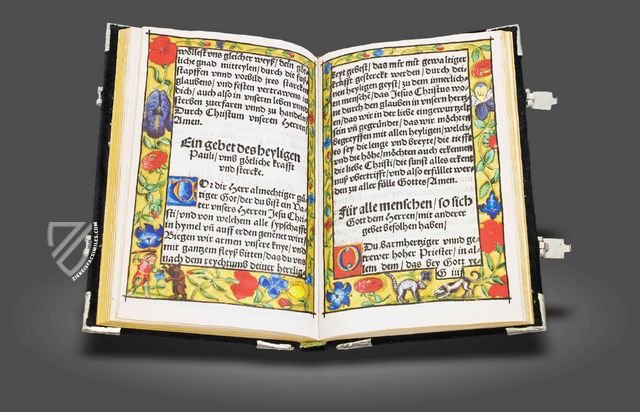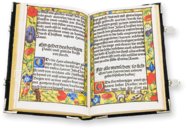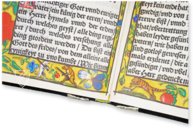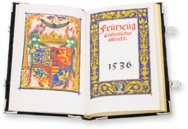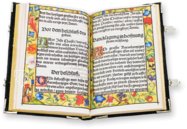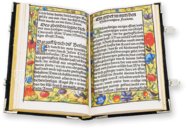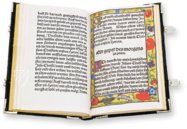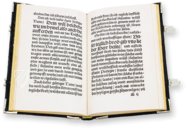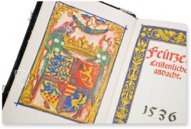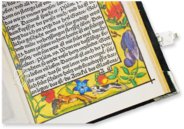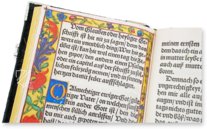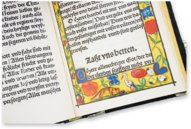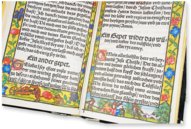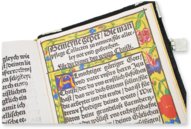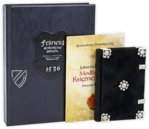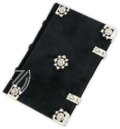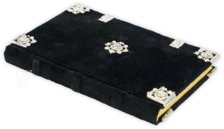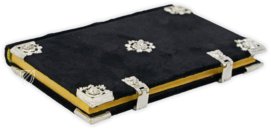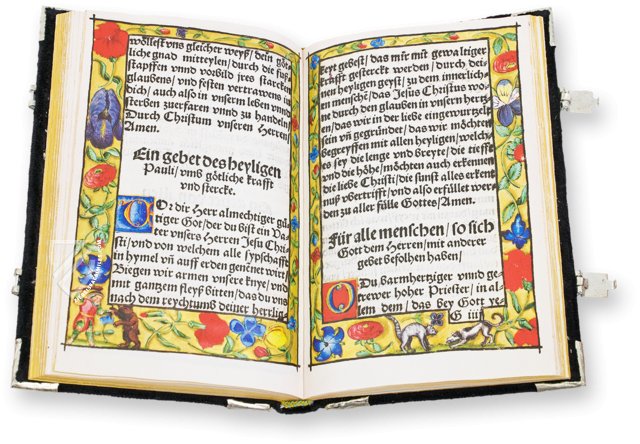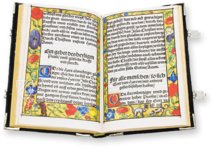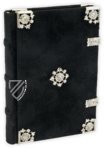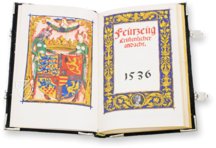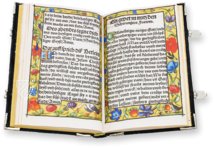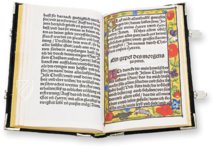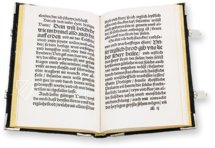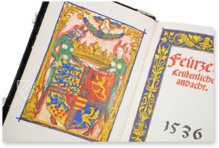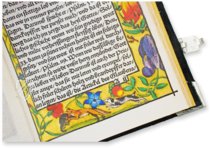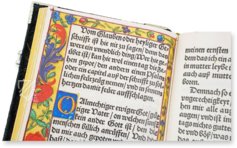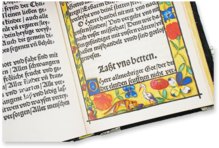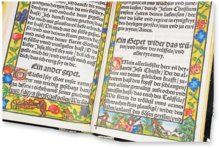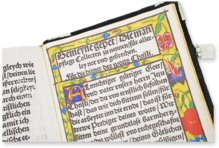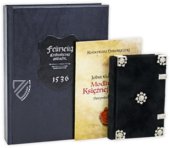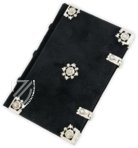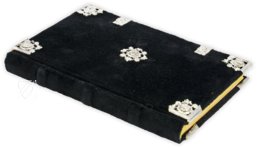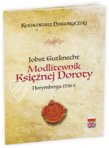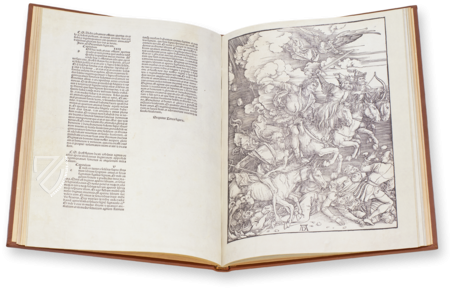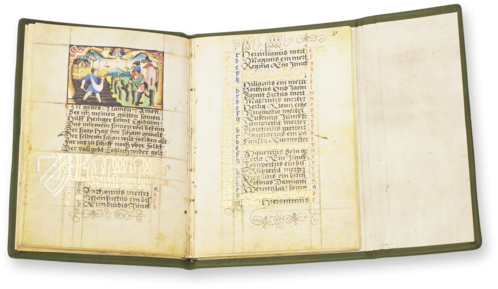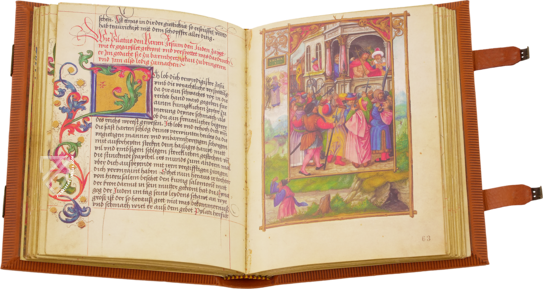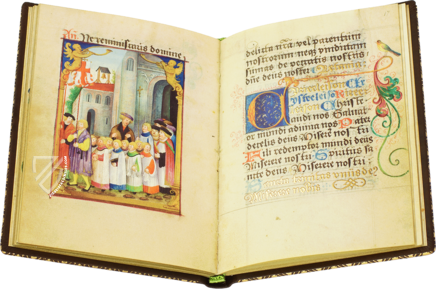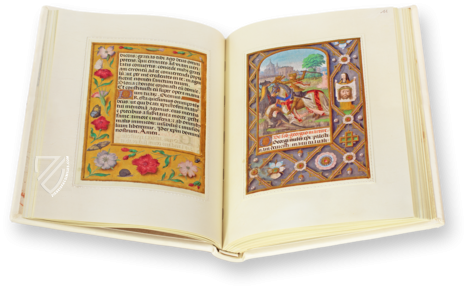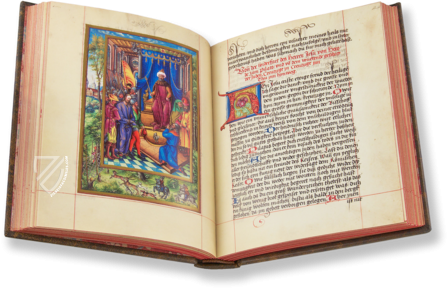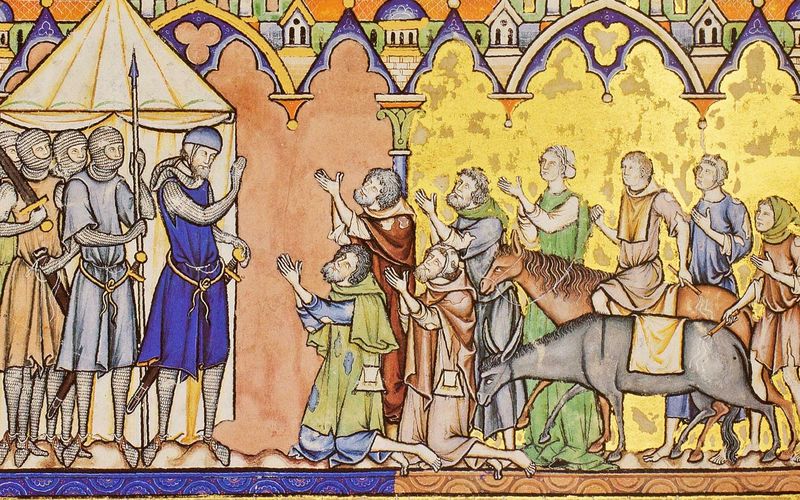Duchess Dorothea's Prayer Book
(1,000€ - 3,000€)
The princely Prussian couple Dorothea and Albrecht were completely devoted to Protestant beliefs and shaped their rule in accordance with the teachings of the Protestant faith. Duke Albrecht commissioned numerous prayer and devotional books for the religious education of his young wife Dorothea, all of them of high worth and made with exceptional diligence. Duchess Dorothea's Prayer Book, which was made in 1536 in the Nuremberg workshop of the artist Nikolaus Glockendon, represents her most splendid codex. The printed book was elaborately decorated by hand with high-quality colors and precious gold leaf in style of the great handwritten and hand-illuminated books of hours by Flemish and Dutch illuminators. Furthermore, it is furnished with a precious binding of black velvet studded with precious gemstones as well as silver fittings and claps. It is the most beautiful and personal book from the princely library to survive to the present.
Duchess Dorothea's Prayer Book
As a princely couple, Dorothea and Albrecht von Preußen were famous for their ardent Protestant faith. A large number of devotional books and texts originated in Albrecht’s name, the most powerful proponent of the Reformation in the Prussian state. The small prayer book belonging to Duchess Dorothea is one of the few pieces from that princely library to have survived to the present. It possesses a special value and status among all of the noble pair’s splendid works. The text of the incredibly richly decorated prayer book is printed, having said that, all of the miniatures and marginal decorations were handmade. Girded with a preciously adorned, valuable binding, the small book is a unique witness to the great cultural wealth of the bygone state of Prussia.
Prussian Protestantism
Dorothea of Prussia way a Danish princess and the first Duchess of Prussia. When she was married to Margrave Albrecht von Ansbach-Brandenburg, Duke of Prussia on July 1st, 1526, the ideas of the Reformation were already widespread in her new abode. Albrecht was an enthusiastic supporter of Martin Luther, was in good standing with the Reformer from Wittenberg, and undertook to reign over Prussia as a humble and responsible protestant sovereign. His wife Dorothea went to great lengths to emulate the Duke in his faith and found him to be a patient teacher. Numerous sources tell of how the prince commissioned theological texts, bibles, and devotional books for his wife in order to give her an understanding of the teachings of the protestant faith.
The Genesis of a Masterpiece
A few written sources contain information about the genesis of Duchess Dorothea's Prayer Book. A letter by Albrecht concerning the prayer book was addressed to the Nuremberg artists Arnold Wenck and Nikolaus Glockendon. The letter relates the personal wishes of the Duke, according to which his wife’s gift was to be manufactured. It was intended to correspond to the style of the great handwritten and hand-illuminated books of hours by Flemish and Dutch illuminators. His prayer texts were printed, but all of the decoration and illumination of the book was finished with the use of high-quality colors and precious gold leaf applied by hand. Elaborate floral patterns and depictions of animals in an inconceivable variety adorn the margins of the pages. The illumination is reminiscent of the famous fables of the ancient Greek poet Aesop. The exceptional binding of the prayer book consists of black velvet studded with precious gemstones as well as silver fittings and claps. All of these precious and unbelievably expensive elements of décor speak to the very personal character of the masterful prayer book.
Codicology
- Alternative Titles
- Modlitewnik Księżnej Doroty
Jobst Gutknecht, Feuerzeug Christlicher Andacht
Gebetbuch der Herzogin Dorothea von Preussen - Size / Format
- 148 pages / 17.5 × 12.0 cm
- Origin
- Germany
- Date
- 1536
- Epochs
- Style
- Genre
- Language
- Illustrations
- 1 frontispiece, 1 title page, 44 floral borders with drôleries
- Content
- Protestant prayers
- Patron
- Duke Albert of Prussia, Grand Master of the Teutonic Order (1490–1568)
- Artist / School
- Nikolaus Glockendon (ca. 1490/95–1533/34) (illuminator)
Jobst Gutknecht (printer) - Previous Owners
- Duchess Dorothea of Prussia (1504–1547)
Duchess Dorothea's Prayer Book
Angel Training a Dog
Gorgeous hand drawn frames surround the printed text throughout most of this wonderful hybrid work. Here we see a wonderful golden frame filled with various brightly colored flowers, as one would expect, but there are also some curious figures at the bottom of the page. A white dog is being trained to jump through a loop by an angel wearing a red tunic. The dog is depicted as it is about to leap through the hoop with its front legs up in the air as it pushes off with its hind legs.
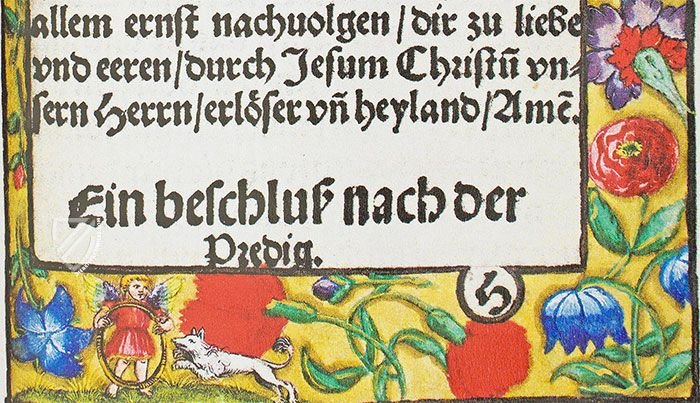
Duchess Dorothea's Prayer Book
Frontispiece
Lions, hearts, a dragon, and even a goose adorn the coat of arms being held up by two onocentaurs instead of the Duke and Duchess of Prussia. An onocentaur is a medieval variation of the centaur from classical mythology, but part human and part donkey with only two legs instead of four. In medieval bestiaries, the onocentaur represents the conflict between one’s humanity and one’s more animalistic character.
The choice of these hybrid beings for the frontispiece instead of its patron and recipient may be a reflection of the Reformation, when many were examining their faith across Europe. Nevertheless, this hand drawn miniature is very fine and depicts the creatures with green fur, red horns and hooves, but otherwise natural and human looking faces and hands.
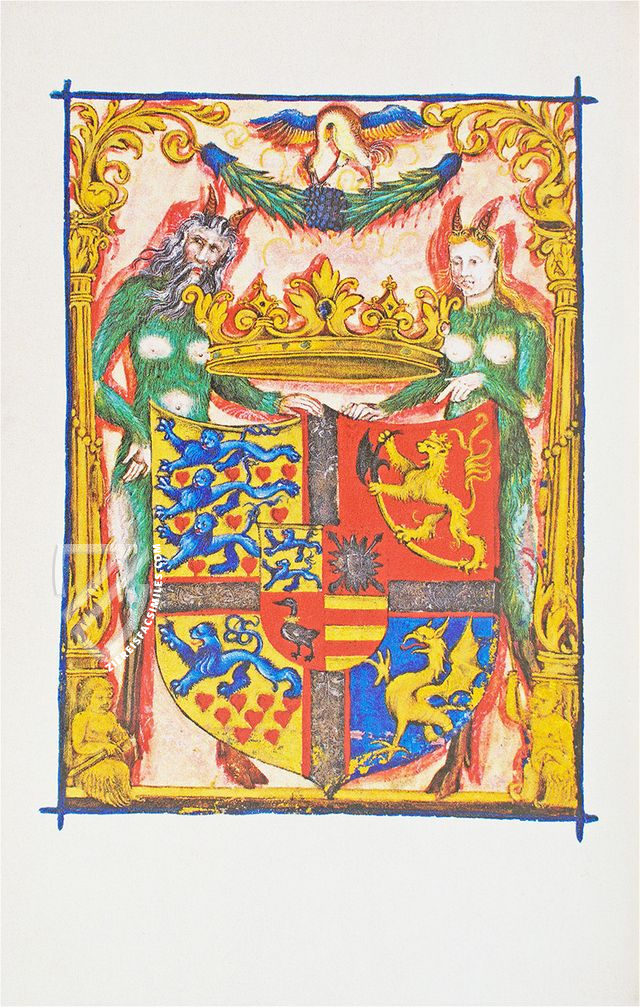
#1 Modlitewnik Księżnej Doroty
Languages: English, Polish
(1,000€ - 3,000€)
- Treatises / Secular Books
- Apocalypses / Beatus
- Astronomy / Astrology
- Bestiaries
- Bibles / Gospels
- Chronicles / History / Law
- Geography / Maps
- Saints' Lives
- Islam / Oriental
- Judaism / Hebrew
- Single Leaf Collections
- Leonardo da Vinci
- Literature / Poetry
- Liturgical Manuscripts
- Medicine / Botany / Alchemy
- Music
- Mythology / Prophecies
- Psalters
- Other Religious Books
- Games / Hunting
- Private Devotion Books
- Other Genres
- Afghanistan
- Armenia
- Austria
- Belgium
- Belize
- Bosnia and Herzegovina
- China
- Colombia
- Costa Rica
- Croatia
- Cyprus
- Czech Republic
- Denmark
- Egypt
- El Salvador
- Ethiopia
- France
- Germany
- Greece
- Guatemala
- Honduras
- Hungary
- India
- Iran
- Iraq
- Israel
- Italy
- Japan
- Jordan
- Kazakhstan
- Kyrgyzstan
- Lebanon
- Liechtenstein
- Luxembourg
- Mexico
- Morocco
- Netherlands
- Palestine
- Panama
- Peru
- Poland
- Portugal
- Romania
- Russia
- Serbia
- Spain
- Sri Lanka
- Sweden
- Switzerland
- Syria
- Tajikistan
- Turkey
- Turkmenistan
- Ukraine
- United Kingdom
- United States
- Uzbekistan
- Vatican City
- A. Oosthoek, van Holkema & Warendorf
- Aboca Museum
- Ajuntament de Valencia
- Akademie Verlag
- Akademische Druck- u. Verlagsanstalt (ADEVA)
- Aldo Ausilio Editore - Bottega d’Erasmo
- Alecto Historical Editions
- Alkuin Verlag
- Almqvist & Wiksell
- Amilcare Pizzi
- Andreas & Andreas Verlagsbuchhandlung
- Archa 90
- Archiv Verlag
- Archivi Edizioni
- Arnold Verlag
- ARS
- Ars Magna
- ArtCodex
- AyN Ediciones
- Azimuth Editions
- Badenia Verlag
- Bärenreiter-Verlag
- Belser Verlag
- Belser Verlag / WK Wertkontor
- Benziger Verlag
- Bernardinum Wydawnictwo
- BiblioGemma
- Biblioteca Apostolica Vaticana (Vaticanstadt, Vaticanstadt)
- Bibliotheca Palatina Faksimile Verlag
- Bibliotheca Rara
- Boydell & Brewer
- Bramante Edizioni
- Bredius Genootschap
- Brepols Publishers
- British Library
- C. Weckesser
- Caixa Catalunya
- Canesi
- CAPSA, Ars Scriptoria
- Caratzas Brothers, Publishers
- Carus Verlag
- Casamassima Libri
- Centrum Cartographie Verlag GmbH
- Chavane Verlag
- Christian Brandstätter Verlag
- Circulo Cientifico
- Club Bibliófilo Versol
- Club du Livre
- CM Editores
- Collegium Graphicum
- Collezione Apocrifa Da Vinci
- Comissão Nacional para as Comemorações dos Descobrimentos Portugueses
- Coron Verlag
- Corvina
- CTHS
- D. S. Brewer
- Damon
- De Agostini/UTET
- De Nederlandsche Boekhandel
- De Schutter
- Deuschle & Stemmle
- Deutscher Verlag für Kunstwissenschaft
- DIAMM
- Droz
- E. Schreiber Graphische Kunstanstalten
- Ediciones Boreal
- Ediciones Grial
- Ediclube
- Edições Inapa
- Edilan
- Editalia
- Edition Deuschle
- Edition Georg Popp
- Edition Leipzig
- Edition Libri Illustri
- Editiones Reales Sitios S. L.
- Éditions de l'Oiseau Lyre
- Editions Medicina Rara
- Editorial Casariego
- Editorial Mintzoa
- Editrice Antenore
- Editrice Velar
- Edizioni Edison
- Egeria, S.L.
- Eikon Editores
- Electa
- Emery Walker Limited
- Enciclopèdia Catalana
- Eos-Verlag
- Ephesus Publishing
- Ernst Battenberg
- Eugrammia Press
- Extraordinary Editions
- Fackelverlag
- Facsimila Art & Edition
- Facsimile Editions Ltd.
- Facsimilia Art & Edition Ebert KG
- Faksimile Verlag
- Feuermann Verlag
- Folger Shakespeare Library
- Franco Cosimo Panini Editore
- Friedrich Wittig Verlag
- Fundación Hullera Vasco-Leonesa
- G. Braziller
- Gabriele Mazzotta Editore
- Gebr. Mann Verlag
- Gesellschaft für graphische Industrie
- Getty Research Institute
- Giovanni Domenico de Rossi
- Giunti Editore
- Graffiti
- Grafica European Center of Fine Arts
- Guido Pressler
- Guillermo Blazquez
- Gustav Kiepenheuer
- H. N. Abrams
- Harrassowitz
- Harvard University Press
- Helikon
- Hendrickson Publishers
- Henning Oppermann
- Herder Verlag
- Hes & De Graaf Publishers
- Hoepli
- Holbein-Verlag
- Houghton Library
- Hugo Schmidt Verlag
- Idion Verlag
- Il Bulino, edizioni d'arte
- ILte
- Imago
- Insel Verlag
- Insel-Verlag Anton Kippenberger
- Instituto de Estudios Altoaragoneses
- Instituto Nacional de Antropología e Historia
- Introligatornia Budnik Jerzy
- Istituto dell'Enciclopedia Italiana - Treccani
- Istituto Ellenico di Studi Bizantini e Postbizantini
- Istituto Geografico De Agostini
- Istituto Poligrafico e Zecca dello Stato
- Italarte Art Establishments
- Jan Thorbecke Verlag
- Johnson Reprint Corporation
- Josef Stocker
- Josef Stocker-Schmid
- Jugoslavija
- Karl W. Hiersemann
- Kasper Straube
- Kaydeda Ediciones
- Kindler Verlag / Coron Verlag
- Kodansha International Ltd.
- Konrad Kölbl Verlag
- Kurt Wolff Verlag
- La Liberia dello Stato
- La Linea Editrice
- La Meta Editore
- Lambert Schneider
- Landeskreditbank Baden-Württemberg
- Leo S. Olschki
- Les Incunables
- Liber Artis
- Library of Congress
- Libreria Musicale Italiana
- Lichtdruck
- Lito Immagine Editore
- Lumen Artis
- Lund Humphries
- M. Moleiro Editor
- Maison des Sciences de l'homme et de la société de Poitiers
- Manuscriptum
- Martinus Nijhoff
- Maruzen-Yushodo Co. Ltd.
- MASA
- Massada Publishers
- McGraw-Hill
- Metropolitan Museum of Art
- Militos
- Millennium Liber
- Müller & Schindler
- Nahar - Stavit
- Nahar and Steimatzky
- National Library of Wales
- Neri Pozza
- Nova Charta
- Oceanum Verlag
- Odeon
- Orbis Mediaevalis
- Orbis Pictus
- Österreichische Staatsdruckerei
- Oxford University Press
- Pageant Books
- Parzellers Buchverlag
- Patrimonio Ediciones
- Pattloch Verlag
- PIAF
- Pieper Verlag
- Plon-Nourrit et cie
- Poligrafiche Bolis
- Presses Universitaires de Strasbourg
- Prestel Verlag
- Princeton University Press
- Prisma Verlag
- Priuli & Verlucca, editori
- Pro Sport Verlag
- Propyläen Verlag
- Pytheas Books
- Quaternio Verlag Luzern
- Reales Sitios
- Recht-Verlag
- Reichert Verlag
- Reichsdruckerei
- Reprint Verlag
- Riehn & Reusch
- Roberto Vattori Editore
- Rosenkilde and Bagger
- Roxburghe Club
- Salerno Editrice
- Saltellus Press
- Sandoz
- Sarajevo Svjetlost
- Schöck ArtPrint Kft.
- Schulsinger Brothers
- Scolar Press
- Scrinium
- Scripta Maneant
- Scriptorium
- Shazar
- Siloé, arte y bibliofilia
- SISMEL - Edizioni del Galluzzo
- Sociedad Mexicana de Antropología
- Société des Bibliophiles & Iconophiles de Belgique
- Soncin Publishing
- Sorli Ediciones
- Stainer and Bell
- Studer
- Styria Verlag
- Sumptibus Pragopress
- Szegedi Tudomànyegyetem
- Taberna Libraria
- Tarshish Books
- Taschen
- Tempus Libri
- Testimonio Compañía Editorial
- Thames and Hudson
- The Clear Vue Publishing Partnership Limited
- The Facsimile Codex
- The Folio Society
- The Marquess of Normanby
- The Richard III and Yorkist History Trust
- Tip.Le.Co
- TouchArt
- TREC Publishing House
- TRI Publishing Co.
- Trident Editore
- Tuliba Collection
- Typis Regiae Officinae Polygraphicae
- Union Verlag Berlin
- Universidad de Granada
- University of California Press
- University of Chicago Press
- Urs Graf
- Vallecchi
- Van Wijnen
- VCH, Acta Humaniora
- VDI Verlag
- VEB Deutscher Verlag für Musik
- Verlag Anton Pustet / Andreas Verlag
- Verlag Bibliophile Drucke Josef Stocker
- Verlag der Münchner Drucke
- Verlag für Regionalgeschichte
- Verlag Styria
- Vicent Garcia Editores
- W. Turnowski Ltd.
- W. Turnowsky
- Waanders Printers
- Wiener Mechitharisten-Congregation (Wien, Österreich)
- Wissenschaftliche Buchgesellschaft
- Wissenschaftliche Verlagsgesellschaft
- Wydawnictwo Dolnoslaskie
- Xuntanza Editorial
- Zakład Narodowy
- Zollikofer AG

